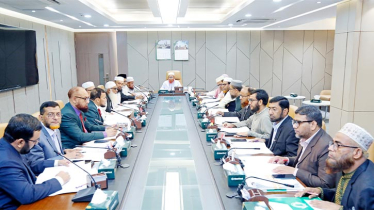
Photo: Collected
Dhaka, the capital of Bangladesh, is grappling with severe load shedding, facing power outages two to three times daily due to insufficient power generation. This frequent disruption is affecting both uninterruptible power supplies (IPS) and generators, creating widespread inconvenience.
Once a priority for power distribution, Dhaka now suffers from a strained supply system. Despite having a more robust infrastructure compared to other regions, the capital is facing significant challenges in power generation and distribution.
The situation is exacerbated by the shutdown of Dinajpur's Barapukuria Thermal Power Station, which has a 525 MW capacity but is currently offline due to a malfunctioning electro-hydraulic well pump. This shutdown is contributing to a nationwide shortfall of approximately 280 to 285 MW.
In this context, Salehuddin Ahmed, Finance and Trade Advisor to the government, stated that it will take some time to stabilize the electricity situation. He noted that "the government is prioritizing the import of fuel and coal."
Energy Adviser Muhammad Fawzul Kabir Khan expressed optimism about receiving budget support for the energy and power sector by next December.
Summit, the largest power generation company, has stopped supplying LNG for four months, resulting in a 500 mmcfd gas shortage for the national grid and an increase in load shedding.
Moreover, the Matarbari mega project is generating only 700 MW despite having a capacity of 1,320 MW due to a coal shortage. Similarly, S Alam’s SS Power is producing only 600 MW out of its 1,200 MW capacity.
A resident of Dhaka's Bonosree area reported that load shedding occurred three times on Tuesday, with each outage lasting for an hour. They mentioned that their inverter power supply (IPS) could not support the outages. Sumayya from the Basabo area noted that children are suffering the most due to these disruptions.
Additionally, there have been reports of load shedding in several areas of Mirpur, along with gas shortages. Many people are sharing their experiences of load shedding on social media. Officials from various organizations have indicated that frequent load shedding is causing problems in their work as well.
Meanwhile, outside the capital, widespread load shedding has been reported across Chattogram, Borishal, Patuakhali, Rangpur, Rajshahi, Sylhet, Cumilla, Dinajpur, Mymensingh, Tangail, Gazipur, and Savar. Residents have noted that they haven't experienced such prolonged outages even during the peak of summer heat. Currently, once the power goes out, it often remains off for two to two and a half hours at a stretch.
Distribution companies have attributed these outages to an ongoing energy crisis and the shutdown of several power plants for repairs, leading to a significant decrease in electricity production. According to the Ministry of Power, Energy, and Mineral Resources, the country’s power generation capacity is 31,520 MW. On April 30, the maximum electricity generated was 16,477 megawatts.
Officials from power distribution companies have indicated that several power plants with a combined production capacity of 3,500 MW are currently offline for maintenance. Additionally, due to the energy crisis, electricity production has decreased by 6,287 megawatts.
According to the Power Grid Company, the electricity demand on Tuesday (September 10) at 3 pm was 14,750 MW, while electricity generation was only 12,788 MW. This results in a daily shortfall of approximately 2,000 megawatts, which is being addressed through load shedding.
In Dinajpur, all three units of the Barapukuria power plant, which provides electricity to at least three districts in the northern part of the country, have halted production. On Monday (September 9) evening, production ceased due to the failure of the well pump in Unit No. 3. Earlier, Unit No. 1 was shut down on September 7, and Unit No. 2 has been offline for over two years for major overhauling.
Chief Engineer of the Barapukuria Thermal Power Plant, Abu Bakar Siddique, stated, "Unit No. 3, with a generation capacity of 300 MW, is currently closed due to equipment failure. It may take up to two weeks to restart the affected units."
He added that the closure of the plant will result in a reduction of 280 to 285 MW of available electricity, necessitating corresponding load shedding measures.
With the combination of high temperatures and ongoing load shedding, public life has been significantly disrupted.
On Tuesday (September 10), the interim government's finance and industry advisor acknowledged the situation at the secretariat, stating, "It will take some time for the electricity situation to normalize."
Messenger/Disha








